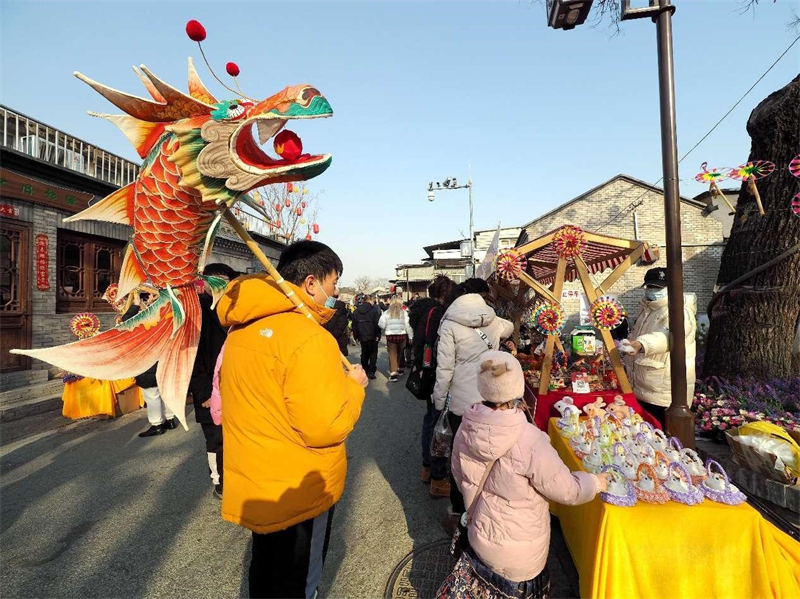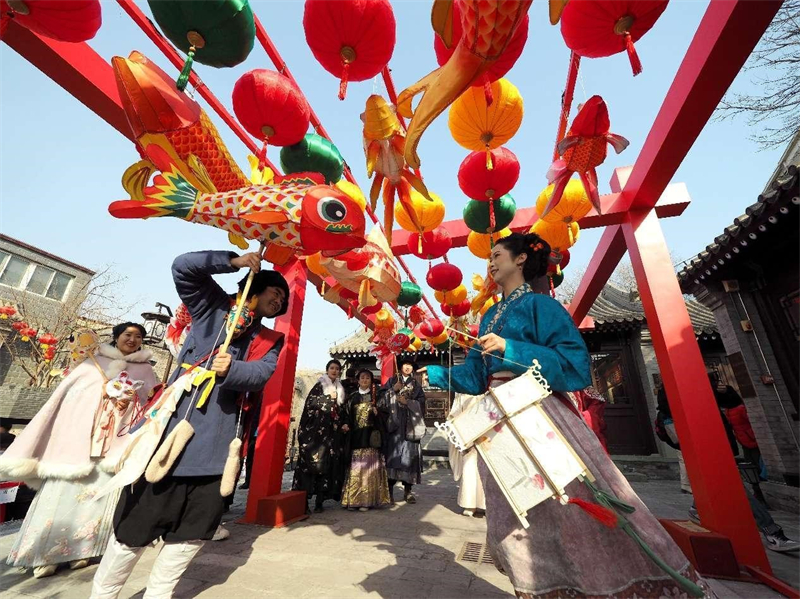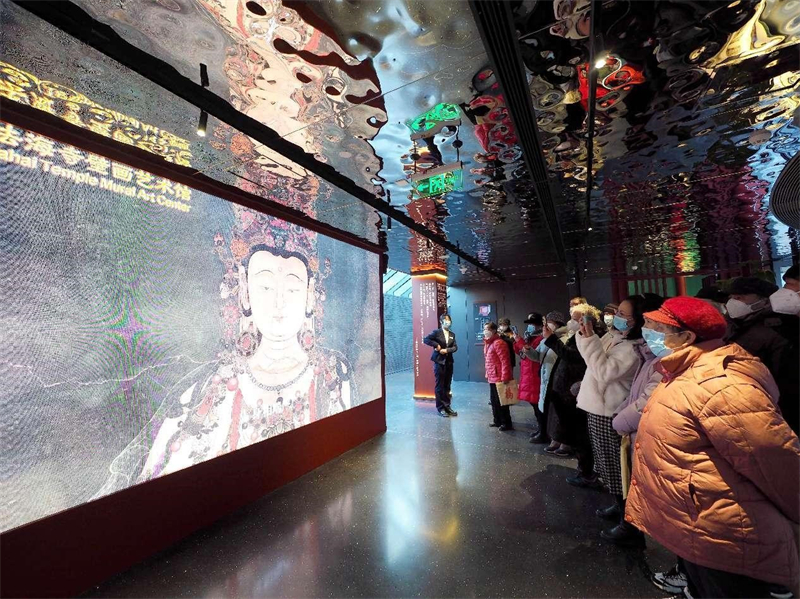Urban renewal gives century-old block new look in Beijing

Tourists shop in the Moshikou historical and cultural block in Shijingshan district, Beijing for the Lantern Festival, Feb. 24, 2024. [People's Daily Online/Du Jianpo]
When the night falls, Moshikou Street in Beijing's Shijingshan district is ablaze with dazzling lights, becoming an ideal photo spot for tourists. This centuries-old historical and cultural block has been reinvigorated thanks to the urban renewal program launched by Beijing.
Having made its name since the Ming Dynasty (1368-1644) and the Qing Dynasty (1644-1911), the Moshikou Street was once a hub for merchants. It covers an area of 38.88 hectares and was among the second batch of historical and cultural preservation areas in Beijing.
It is home to historical and cultural sites protected at the national level including the Fahai Temple and the Cheng'en Temple, as well as many protected at the municipal and district levels.
Having restored historical and cultural sites, as well as former residences of celebrities and valuable courtyards scattered in ancient alleys and lanes, Shijingshan district has launched special cultural exhibitions to highlight the charm of the local culture.
The Fahai Temple is located at the southern foot of Cuiwei Mountain in the western part of Beijing. It houses the oldest and most well-preserved Ming Dynasty murals in Beijing.
Inside the nearby Fahai Temple Mural Art Center, there is a digital exhibition hall where murals are displayed on 4K high-definition screens in their original proportions.
"The screen allows for zooming in, showcasing specific details," said Liu Xiaobo, curator of the Fahai Temple Mural Art Center. This approach not only protects the murals but also better showcases their artistic charm, Liu added.

Folk culture performance is staged in the Moshikou historical and cultural block in Shijingshan district, Beijing, Feb. 24, 2024. (People's Daily Online/Du Jianpo]
Protecting historical heritage helps preserve urban memory. So far, Shijingshan district has allocated a total of over 20 million yuan ($2.78 million) of special funds in the Moshikou historical and cultural block, which has been used for the protective restoration of cultural relics.
In the past, Moshikou block was plagued by illegal buildings, unauthorized roadside businesses, and severe traffic congestion from morning to night. After the morning market finished, the streets were littered with garbage and covered by sewage.
A turnaround came in 2016 when Shijingshan district initiated the renovation work of the Moshikou historical and cultural block, which aimed to improve the environment, upgrade municipal facilities, and enhance the living conditions of residents.
Zhang Haibin, deputy general manager of the company responsible for demolishing illegal constructions and renovating facilities in the block, told People's Daily that various needs were taken into consideration during the design phase of the renovation program.
The goal was not only to improve the living environment for residents but also to restore the historical and cultural charm of the area, attracting both locals and tourists to visit, Zhang said.
The company laid gas pipelines, separated rainwater pipes from sewage pipes, and buried overhead cables underground. Besides, illegal buildings have been demolished orderly. The facades of the block have been renovated with gray brick elements, preserving the traditional features of local residences.
The improvement of the block's landscape focused on enhancing cultural and historical elements and enriching people's life interests. Sculptures, wall paintings, night lighting, and landscaping have been added on both sides of the street.

Tourists visit the Fahai Temple Mural Art Center in the Moshikou historical and cultural block in Shijingshan district, Beijing. [People's Daily Online/Du Jianpo]
The thorough renovation has brought a new look to the Moshikou block. "It has become clean and beautiful, and made everyone's life more convenient," said Ren Yuan, a staff member of the Moshikou village community committee.
"During the renovation, we fully incorporated the demands of the merchants, ensuring that they could open for business as soon as they moved in," said Li Qi, deputy general manager of the Moshikou historical and cultural block operation and maintenance center of Beijing TeFo Heng Investment and Development Co., Ltd.
The block attracted investment focusing on four types of businesses: culture, tourism, commerce, and public services. Today, it is home to 15 landscape sites, 29 exquisite courtyards, and over 100 stores.
"Previously, we must make further renovation and decoration after the block's overall renovation work was finished, which wasted time and energy. This time, our decoration needs were combined directly with remodeling construction of the block, so that our hotel can open for business in the shortest time possible," said Zhao Zhongyuan, who runs a B&B hotel in Moshikou block.
Nowadays, the Moshikou historical and cultural block is home to a variety of businesses, including themed restaurants, hotels, coffee shops, bars, tea houses, and more. In a folk custom exhibition hall in the block, a cafe has opened.
"The folk culture and the cafe have great 'chemistry' - this place is becoming more and more popular," said Zheng Tengfei who runs the cafe. He has gradually come to understand the local folklore and history, and sometimes even introduces it to visitors.
It is reported that the Moshikou historical and cultural block combines light art with bars, B&B hotels, immersive experiences, and other cultural and leisure businesses to further beautify its night views and promote cultural consumption.
























